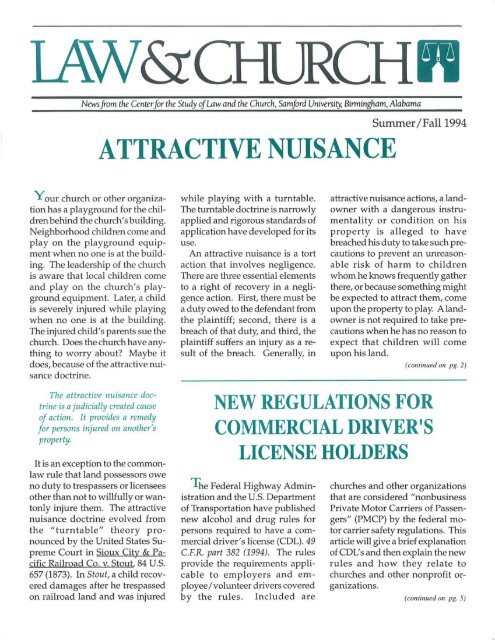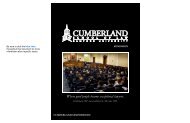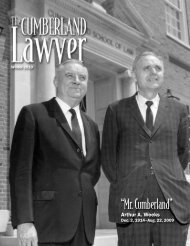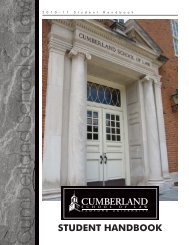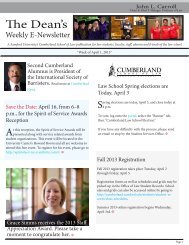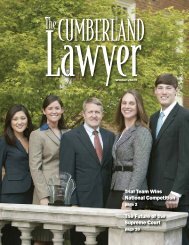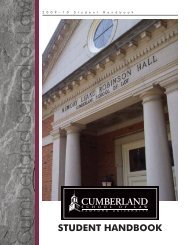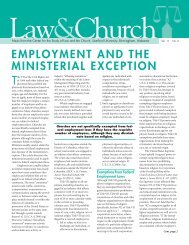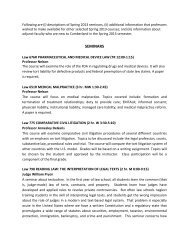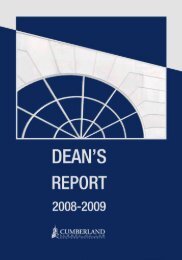attractive nuisance - Cumberland School of Law - Samford University
attractive nuisance - Cumberland School of Law - Samford University
attractive nuisance - Cumberland School of Law - Samford University
Create successful ePaper yourself
Turn your PDF publications into a flip-book with our unique Google optimized e-Paper software.
News from the Center Jor the Study oj <strong>Law</strong> and the Church. SamJord <strong>University</strong>, Birmingham. Alabama<br />
Y our church or other organization<br />
has a playground for the children<br />
behind the church's building.<br />
Neighborhood children corne and<br />
play on the playground equipment<br />
when no one is at the building.<br />
The leadership <strong>of</strong> the church<br />
is aware that local children corne<br />
and play on the church's playground<br />
equipment. Later, a child<br />
is severely injured while playing<br />
when no one is at the building.<br />
The injured child's parents sue the<br />
church. Does the church have anything<br />
to worry about? Maybe it<br />
does, because <strong>of</strong> the <strong>attractive</strong> <strong>nuisance</strong><br />
doctrine.<br />
The <strong>attractive</strong> <strong>nuisance</strong> doctrine<br />
is a judicially created cause<br />
<strong>of</strong> action. It provides a remedy<br />
for persons injured on another's<br />
properhJ<br />
It is an exception to the commonlaw<br />
rule that land possessors owe<br />
no duty to trespassers or licensees<br />
other than not to willfully or wantonly<br />
injure them. The <strong>attractive</strong><br />
<strong>nuisance</strong> doctrine evolved from<br />
the " turntable" theory pronounced<br />
by the United States Supreme<br />
Court in Sioux City & Pacific<br />
Railroad Co. v. Stout. 84 U.s.<br />
657 (1873). In Stout, a child recovered<br />
damages after he trespassed<br />
on railroad land and was injured<br />
ATTRACTIVE NUISANCE<br />
while playing with a turntable.<br />
The turntable doctrine is narrowly<br />
applied and rigorous standards <strong>of</strong><br />
application have developed for its<br />
use.<br />
An <strong>attractive</strong> <strong>nuisance</strong> is a tort<br />
action that involves negligence.<br />
There are three essential elements<br />
to a right <strong>of</strong> recovery in a negligence<br />
action. First, there must be<br />
a duty owed to the defendant from<br />
the plaintiff; second, there is a<br />
breach <strong>of</strong> that duty, and third, the<br />
plaintiff suffers an injury as a result<br />
<strong>of</strong> the breach. Generally, in<br />
Summer/Fall 1994<br />
<strong>attractive</strong> <strong>nuisance</strong> actions, a landowner<br />
with a dangerous instrumentality<br />
or condition on his<br />
property is alleged to have<br />
breached his duty to take such precautions<br />
to prevent an unreasonable<br />
risk <strong>of</strong> harm to children<br />
whom he knows frequently gather<br />
there, or because something might<br />
be expected to attract them, corne<br />
upon the property to play. A landowner<br />
is not required to take precautions<br />
when he has no reason to<br />
expect that children will corne<br />
upon his land.<br />
NEW REGULATIONS FOR<br />
COMMERCIAL DRIVER'S<br />
LICENSE HOLDERS<br />
T he Federal Highway Administration<br />
and the U.S. Department<br />
<strong>of</strong> Transportation have published<br />
new alcohol and drug rules for<br />
persons required to have a commercial<br />
driver's license (COL). 49<br />
C.F.R. part 382 (1994). The rules<br />
provide the requirements applicable<br />
to employers and employee/volunteer<br />
drivers covered<br />
by the rules. Included are<br />
( continued 0 11 pg. 2)<br />
churches and other organizations<br />
that are considered "nonbusiness<br />
Private Motor Carriers <strong>of</strong> Passengers"<br />
(PMCP) by the federal motor<br />
carrier safety regulations. This<br />
article will give a brief explanation<br />
<strong>of</strong> COL's and then explain the new<br />
rules and how they relate to<br />
churches and other nonpr<strong>of</strong>it organizations.<br />
(confirmed Oil pg. 5)
Attractive Nuisance continued ...<br />
The duty owed by a landowner<br />
depend s on the status <strong>of</strong> the<br />
unjured party in relation to the<br />
defendant's land . At commonlaw,<br />
there are three classifications<br />
<strong>of</strong> persons who enter another's<br />
property: invitee, licensee, and<br />
trespasser. Invitees are those with<br />
an express invitation from the occupier,<br />
such as business visitors<br />
and others, who come upon the<br />
premises to serve an interest or<br />
advantage mutual to the occupier<br />
and the visitor. The duty owed the<br />
invitee by the landowner is to keep<br />
his premises in a reasonably safe<br />
condition; to discover and warn<br />
the invitee <strong>of</strong> unreasonably dangerous<br />
conditions <strong>of</strong> which the<br />
landowner either knows or ought<br />
to know and not to wilfully or<br />
wantonly injure the invitee. If a<br />
p erson is on the lan downer 's<br />
property with his consent or as his<br />
guest, but with no business purpose,<br />
he attains the status <strong>of</strong> a licensee.<br />
A licensee must not be willfull<br />
y or wantonly injured or negligently<br />
injured after the landowner<br />
has discovered his peril. A<br />
trespasser is a person who enters<br />
or remains upon the land <strong>of</strong> another<br />
without the consent or privilege<br />
to do so. The landowner owes<br />
a trespasser only the duty not to<br />
wantonly or intentionally injure<br />
him.<br />
A proprietor has the duty to<br />
inspect his premises to become<br />
sufficiently advised<br />
to meet the demand <strong>of</strong> his<br />
duty toward those who it is<br />
reasonable to expect will<br />
enter his premises. It is no<br />
defense that he constructed<br />
and maintained the dangerous<br />
instrumentality in the<br />
same manner as others constructing<br />
and maintaining<br />
other such well-regulated<br />
instrumentalities. R.<br />
Clifford Fulford, The Tort Liability<br />
<strong>of</strong> Possessors <strong>of</strong> Property<br />
to Trespassing Children<br />
In A labama, 11 ALA. L. REV.<br />
1, 17 (1958).<br />
Some states have abandoned the<br />
classification system . In Rowland<br />
v. Christian, 443 P.2d 561 (Cal.<br />
1968), California abolished the traditional<br />
duty classification scheme<br />
for trespassers, licensees and<br />
invitees. Ordinary negligence<br />
principles <strong>of</strong> foreseeable risk and<br />
reason able care replaced the<br />
former classifica tion scheme. After<br />
the Rowland decision, Hawaii,<br />
Maryland, Rhode Island, New<br />
York, New Hampshire, Louisiana,<br />
Alaska, Missouri, and the District<br />
<strong>of</strong> Columbia also abolished all distinctions<br />
between entrants on<br />
land. W. PAGE KEETON ET. AL.,<br />
PROSSER AND KEETON ON THE LAW OF<br />
ToRTS § 62, at 433 (5th ed. 1984).<br />
Another eight states have<br />
adopted the" modified" classification<br />
system in premises actions.<br />
The modified system differs from<br />
the common-law classifica ti on<br />
system in that the distinctions between<br />
licensees and invitees are<br />
discarded but the traditional duty<br />
limitations toward trespassing<br />
adults is retained. States that have<br />
adopted the modified approach<br />
are Connecticut, Florida, Illinois,<br />
Minnesota, Massachusetts, Wisconsin,<br />
North Dakota, and Maine.<br />
David A. Szwak, Note, Louisiana<br />
Premises Liability in the Post-Cates<br />
v. Beauregard Electric Cooperative<br />
Era, 53 LA. L. REV. 1935, 1936 n.ll<br />
(1993).<br />
Under ordinary conditions trespassing<br />
children, or children on<br />
the land <strong>of</strong> another as licensees, occupy<br />
the same position as trespassing<br />
adults. If an injured person<br />
is found to have been on the<br />
- 2 -<br />
defendant's property with his consent<br />
or as his guest, but with no<br />
business purpose, he attains the<br />
status <strong>of</strong> a licensee and must not<br />
be willfully or wantonly injured or<br />
negligently injured after the landowner<br />
has discovered his danger.<br />
The <strong>attractive</strong> <strong>nuisance</strong> doctrine ojfers<br />
an exception to the limited duty<br />
owed by a landowner to a trespasser.<br />
It applies only when trespassing children<br />
are involved. Tolbert v. Gulsbll,<br />
333 So.2d 129 (Ala. 1976).<br />
Initially, an important restriction<br />
<strong>of</strong> the <strong>attractive</strong> <strong>nuisance</strong> doctrine<br />
was tha t the dangerous condi tion<br />
on the landowner's property must<br />
have been naturally <strong>attractive</strong> to<br />
small children. The person had to<br />
be on the property that caused the<br />
injury because <strong>of</strong> something on the<br />
property that attracted him to it.<br />
Additionally, the owner must be<br />
aware that such a person would<br />
be attracted to the property and<br />
whatever w as on it that could<br />
cause injury. The attraction thus<br />
led to an invitation unto the property.<br />
"[A]n invitation may be implied<br />
from the nature <strong>of</strong> the place,<br />
or instrumentality, its use and alluring<br />
qualities calculated to attract<br />
children <strong>of</strong> immature judgment<br />
and lack <strong>of</strong> appreciation <strong>of</strong><br />
the danger." Needham v. Birmingham<br />
Trussville Iron Co .. 157 So.<br />
849,850 (Ala. 1934).<br />
The Supreme Court <strong>of</strong> Alabama<br />
in Tolbert v. Gulsby, 333 So.2d 129<br />
(Ala. 1976), heard a case that involved<br />
a six-year-old child injured<br />
when he was shot in the eye by<br />
another child with an air rifle that<br />
the defendant left propped against<br />
a carport wall. The court decided<br />
that it would adopt Section 339 <strong>of</strong><br />
the Restatement <strong>of</strong> Torts 2d as controlling<br />
in <strong>attractive</strong> <strong>nuisance</strong><br />
claims, regardless <strong>of</strong> whether the
Attractive Nuisance continued ...<br />
children are licensees or trespassers.<br />
According to the Restatement <strong>of</strong><br />
Torts 2d, entitled" Artificial Conditions<br />
Highly Dangerous to Trespassing<br />
Children," an <strong>attractive</strong><br />
<strong>nuisance</strong> claim may exist if certain<br />
conditions are present. Section 339<br />
states the following:<br />
A possessor <strong>of</strong> land is subject to<br />
liability for physical harm to children<br />
trespassing thereon caused<br />
by an artificial condition upon the<br />
land if:<br />
(a) the place where the condition<br />
exists is one upon which the possessor<br />
knows or has reason to<br />
know that children are likely to<br />
trespass, and<br />
(b) the condition is one <strong>of</strong> which<br />
the possessor knows or has reason<br />
to know and which he realized or<br />
should realize will involve an unreasonable<br />
risk <strong>of</strong> death or serious<br />
bodily harm to such children, and<br />
(c) the children because <strong>of</strong> their<br />
youth do not discover the condition<br />
or realize the risk involved in<br />
intermeddling with it or in coming<br />
within the area made dangerous<br />
by it, and<br />
(d) the utility to the possessor <strong>of</strong><br />
maintaining the condition and the<br />
burden <strong>of</strong> eliminating the danger<br />
are slight as compared with the<br />
risk to children involved, and<br />
(e) the possessor fails to exercise<br />
reasonable care to eliminate the<br />
danger or otherwise to protect the<br />
children. REsTATEMENT (SECOND) OF<br />
TORTS § 339 (1979).<br />
The above definition shows that<br />
the term "<strong>attractive</strong> <strong>nuisance</strong>" is a<br />
misnomer. Section 339 <strong>of</strong> the Restatement<br />
<strong>of</strong> Torts 2d does not require<br />
that a child be attracted to<br />
the land possessor's premises by<br />
a dangerous condition or instrumentality<br />
and that he is injured by<br />
the particular attraction. Nor does<br />
§ 339 rely upon the legal fiction <strong>of</strong><br />
"implied invitation" to elevate a<br />
land possessor's duty <strong>of</strong> care to<br />
child trespassers.<br />
Despite these recognized differences,<br />
the courts continue to refer to injuredchild-trespasser<br />
cases popularly as<br />
"<strong>attractive</strong> <strong>nuisance</strong>" cases, even in<br />
those states that do not require the<br />
child's attraction to the dangerous<br />
condition.<br />
Not every dangerous instrumentality<br />
or condition on another<br />
person's property that attracts a<br />
child to it is considered an <strong>attractive</strong><br />
<strong>nuisance</strong>. Even in states that<br />
require a child be "attracted" to a<br />
dangerous condition will not classify<br />
every dangerous condition as<br />
an <strong>attractive</strong> <strong>nuisance</strong>.<br />
[N]ot every instrument<br />
possibly dangerous to a<br />
child <strong>of</strong> tender years, or<br />
which such a child might<br />
convert into a means <strong>of</strong><br />
amusement, constitutes an<br />
<strong>attractive</strong> <strong>nuisance</strong>. On the<br />
contrary, for the <strong>attractive</strong><br />
<strong>nuisance</strong> rule to apply, the<br />
instrumentality or [land]<br />
condition must be <strong>of</strong> a nature<br />
likely to incite the curiosity<br />
<strong>of</strong> a child and [be]<br />
fraught with such danger<br />
as to reasonably require<br />
precaution to prevent children<br />
from making improper<br />
use there<strong>of</strong>.<br />
Patterson v. Recreation and<br />
Park Comm'n, 226 So.2d<br />
211, 216 (La. App. 1st Cir.<br />
1969).<br />
However, a land-owner's<br />
nonconsent to the presence <strong>of</strong> children<br />
on his property, or that he objected<br />
to their presence, is not suf-<br />
- 3 -<br />
ficient to relieve him from liability<br />
if a child is hurt on his property.<br />
For example, a young child<br />
cannot read or appreciate a "No<br />
Trespassing" sign. However,<br />
"[t]his is not to say that the landowner<br />
should be restricted in any<br />
sense in his rights to resist the trespass<br />
by all lawful means or to use<br />
such reasonable force as may be<br />
necessary to remove trespassers<br />
discovered on his premises while<br />
their trespasses are in progress."<br />
R. Clifford Fulford, The Tort Liability<br />
<strong>of</strong> Possessors <strong>of</strong> Property To Trespassing<br />
Children In Alabama, 11 ALA.<br />
L. REv. 1,30 (1958). A landowner<br />
might not escape liability by taking<br />
some precautions to make his<br />
property secure, such as simply<br />
putting up a sign or a fence in an<br />
attempt to keep trespassers <strong>of</strong>f his<br />
property.<br />
The <strong>attractive</strong> <strong>nuisance</strong> doctrine<br />
may vary from state to state. Some<br />
states require that the property<br />
owner must be aware <strong>of</strong> the dangerous<br />
condition on his property<br />
to be liable to an injured party.<br />
Others state the property owner<br />
had to know that children were<br />
drawn to the dangerous condition.<br />
Evidence that children regularly<br />
played on the premises or with the<br />
dangerous instrumentality can be<br />
used to show the landowner had<br />
notice <strong>of</strong> a potential problem.<br />
Some states specifically exempt<br />
certain conditions from being an<br />
<strong>attractive</strong> <strong>nuisance</strong>. For example,<br />
in Eamestv. Regent Pool. Inc., 257<br />
So.2d 313 (Ala. 1972), a father sued<br />
to recover damages for the wrongful<br />
death <strong>of</strong> his nine-year-old son<br />
who drowned in the defendant's<br />
pool. The father argued that the<br />
defendant knew that children constantly<br />
and persistently used the<br />
pool premises and came unto the<br />
property without permission. The<br />
court maintained its earlier prece-
Attractive Nuisance continued ...<br />
dent that the doctrine <strong>of</strong> <strong>attractive</strong><br />
<strong>nuisance</strong> would not be applicable<br />
when the danger is<br />
patent and obvious to a trespassing<br />
child, and the court refused<br />
to an exception.<br />
The court in Regent said "[ilt<br />
is well settled in Alabama that<br />
where the danger from the instrumentality<br />
which caused<br />
the injury is patent and obvious<br />
the doctrine <strong>of</strong> <strong>attractive</strong><br />
<strong>nuisance</strong> is inapplicable." Id. at<br />
316. The court noted that the<br />
<strong>attractive</strong> <strong>nuisance</strong> doctrine<br />
had never been extended in<br />
Alabama to bodies <strong>of</strong> water.<br />
Thus, Alabama courts have<br />
declined to protect trespassing<br />
children from water hazards.<br />
Alabama recognizes no exception,<br />
in cases <strong>of</strong> child trespassers,<br />
to the conventional rule that a landowner<br />
is not liable to a trespasser<br />
on his land when the trespasser is<br />
injured or drowns in a water hazard.<br />
Other conditions that some<br />
courts will not recognize as <strong>attractive</strong><br />
<strong>nuisance</strong>s involve fire,<br />
falling from a height or into an<br />
excavation, moving vehicles,<br />
ordinary visible machinery in<br />
motion, sliding or caving soil,<br />
and piles <strong>of</strong> lumber, crossties,<br />
and other building material.<br />
Some courts expect that a trespassing<br />
child may reasonably<br />
comprehend the danger in<br />
such situations. They explain<br />
that the landowner may assume<br />
that any child <strong>of</strong> sufficient<br />
age, allowed at large by<br />
his parents and so likely to<br />
trespass, will appreciate the<br />
danger and avoid it, or at least<br />
make his own intelligent and<br />
responSible choice. W. PAGE<br />
KEETON ET. AL., PROSSER AND KEETON<br />
ON THE LAW OF TORTS § 59, at 407<br />
(5thed. 1984). Of course, the court<br />
can always make an exception<br />
within any <strong>of</strong> the preceding categories,<br />
i.e., such as if the danger<br />
is partially hidden.<br />
Age can also be a limitation in<br />
an <strong>attractive</strong> <strong>nuisance</strong> action.<br />
Prior to Lyle v. Bouler. 547 So.2d<br />
506 (Ala. 1989), in Alabama no<br />
duty was owed to a minor over the<br />
age <strong>of</strong> fourteen. In Lyle, a sixteenyear-old<br />
boy drove with a friend<br />
onto the defendant's property<br />
without permission. They parked<br />
their car at a clay pit and then repeatedly<br />
climbed up the sides <strong>of</strong><br />
the pit. The purpose <strong>of</strong> climbing<br />
the pit was to see which <strong>of</strong> the two<br />
could climb the highest. During<br />
one climb, the two reached a ledge<br />
and sat on it to rest. Several minutes<br />
later, the ledge collapsed, and<br />
the two boys fell about 15 feet to<br />
the bottom. In the fall, the<br />
plaintiff's back was broken.<br />
The Supreme Court <strong>of</strong> Alabama<br />
said it would no longer use age as<br />
a limitation to liability. Age could<br />
still be an important factor in determining<br />
liability, but it is one <strong>of</strong><br />
several factors that must be considered.<br />
Factors to be considered<br />
included: (1) the intelligence <strong>of</strong> the<br />
child; (2) the capacity <strong>of</strong> the child<br />
to understand the potential danger<br />
<strong>of</strong> the hazard; (3) the child's<br />
actual knowledge <strong>of</strong> the danger;<br />
(4) the child's ability to exercise<br />
discretion; (5) the education level<br />
<strong>of</strong> the child; (6) the maturity <strong>of</strong> the<br />
child; and (7) the age <strong>of</strong> the child.<br />
After all these factors were examined,<br />
then the landowner's conduct<br />
would be examined in accordance<br />
with section 339 <strong>of</strong> the Restatement<br />
<strong>of</strong> Torts 2d.<br />
Decisions in other courts have<br />
also allowed recovery for plaintiffs<br />
- 4 -<br />
over the age <strong>of</strong> 14, especially if<br />
coupled with a physical or<br />
mental disability. Still other<br />
decisions have refused to allow<br />
any recovery for a plaintiff<br />
over the age <strong>of</strong> twelve.<br />
The benefit or advantage the<br />
landowner achieves with a<br />
dangerous condition on his<br />
property must be weighed<br />
against any possible injured<br />
children. A landowner is not<br />
required to alleviate the dangerous<br />
condition at great personal<br />
cost if it is unreasonable<br />
to do so because <strong>of</strong> the amount<br />
<strong>of</strong> risk involved. Some things<br />
are useful and difficult to safeguard,<br />
but are <strong>attractive</strong> to<br />
children.<br />
A landowner, however, is only required<br />
to exercise reasonable care,<br />
and to take only those precautions<br />
that would be taken by a reasonable<br />
person under similar circumstances<br />
against such risks that<br />
could be reasonable foreseen and<br />
prevented.<br />
Churches and other organizations<br />
should be aware <strong>of</strong> any<br />
dangerous conditions or instrumentalities<br />
on their property.<br />
Each organization should<br />
also take adequate steps to secure<br />
its property. Failure to<br />
correct a dangerous condition<br />
or instrumentality, or to prevent<br />
children from injuring<br />
themselves on it, might lead to<br />
potential liability. It
1.<br />
2.<br />
3.<br />
4.<br />
5.<br />
6.<br />
7.<br />
8.<br />
9.<br />
to.<br />
HOW TO PROTECT AGAINST<br />
AN ATTRACTIVE NUISANCE CLAIM<br />
Put up adequate fences and signs around playground<br />
areas.<br />
Make sure that the playground equipment at the<br />
organization meets "industry standards" related to safety.<br />
Conduct periodic inspections to make sure the grounds are<br />
safe and secure.<br />
Conduct periodic building inspections. Make sure that<br />
buildings are secure, including attics and basements.<br />
The organization should consult with its insurance carrier<br />
to discuss adequate liability insurance.<br />
Instruct employees to report to management any known<br />
trespassing.<br />
Be aware <strong>of</strong> any outside children coming onto the<br />
organization's property.<br />
Periodically check that no dangerous conditions exist on<br />
the property or in any buildings.<br />
Establish and carry out a maintenance plan for the<br />
organization's grounds and buildings.<br />
If the organization becomes aware <strong>of</strong> any dangerous<br />
conditions that exists on the property, take steps to either<br />
repair or alleviate such dangerous condition.<br />
NEW REGULATIONS FOR COMMERCIAL<br />
DRIVER'S LICENSE HOLDERS (con tinued!rompagel)<br />
A PMCP provides private,<br />
interstate transportation <strong>of</strong><br />
passengers that is not in furtherance<br />
<strong>of</strong> a commercial purpose<br />
and uses a vehicle designed<br />
to carry more than 15<br />
passen gers, including the<br />
driver (or the vehicle's weight<br />
is greater than 10,000 pounds).<br />
Examples <strong>of</strong> nonbusiness<br />
PMCPs include churches,<br />
scout groups, and other charitable<br />
organizations that may<br />
purchase or lease buses for the<br />
private transportation <strong>of</strong> their respective<br />
groups. The new rules<br />
generally require application beginning<br />
on January 1, 1995 for<br />
large employers (generally, employers<br />
that employ 50 or more<br />
safety-sensitive drivers) and January<br />
1, 1996 for all other employers.<br />
Nonpr<strong>of</strong>it organizations, including<br />
churches, are subject to a federal law<br />
passed in 1986 that requires drivers <strong>of</strong><br />
commercial motor vehicles to have a<br />
- 5 -<br />
commercial driver's license.<br />
The Commercial Motor Vehicle<br />
Safety Act (49 U.s. c. §<br />
2701) requires each individual<br />
state to meet the same minimum<br />
standards for commercial<br />
driver licensing to help reduce<br />
or prevent commercial<br />
motor vehicle (CMV) accidents,<br />
fatalities and injuries.<br />
The Act's purpose is to improve<br />
safety by p ermitting<br />
commercial drivers to hold<br />
only one license (a commercial<br />
driver's license), disqualifying<br />
drivers convicted <strong>of</strong> certain<br />
serious traffic violations, and<br />
stren gthening commercial<br />
driver licensing and testing<br />
standards. The Act requires<br />
drivers <strong>of</strong> certain vehicles to<br />
take both a written test and a<br />
road test to ensure their qualifications<br />
and ability to drive<br />
such vehicles. Churches and<br />
other nonpr<strong>of</strong>it organizations<br />
are not exempt from the Act.<br />
See LAW & CHURCH (Winter<br />
1991).<br />
Commercial licenses are d ivided<br />
into three d ifferent<br />
classes. A driver is issued a<br />
CDL according to the classification<br />
<strong>of</strong> the veh icle . The<br />
classes are:<br />
Class A - 26,001 pound combination<br />
vehicle hauling tO,OOO<br />
pounds or more, e.g., a tractor<br />
trailer.<br />
Class B - 26,001 pound single<br />
vehicle hauling 10,000 pounds<br />
or more, e.g., a school bus.<br />
Class C - a vehicle designed<br />
for 16 or more persons including<br />
the driver, e.g., a van; and<br />
Class D , or the regular<br />
driver 's license, which is the<br />
same type license all drivers<br />
now have and will be valid for
Alcohol and Drug Regulations continued ...<br />
operating noncommercial vehicles<br />
such as passenger cars.<br />
A van designed for 15 or<br />
fewer p eople, including the<br />
driver, would not fall under<br />
Class C and the driver would<br />
only have to have a regular<br />
driver's license. If, however,<br />
an organization uses a van designed<br />
for 16 or more people,<br />
including the driver, the driver<br />
is required to have a Class C<br />
commercial driver's license.<br />
An organization that intends<br />
to use many drivers should<br />
consider only purchasing or<br />
acquiring vehicles designed to<br />
seat 15 or fewer persons.<br />
Under the Act, each driver<br />
will have only one driver's license.<br />
A driver may operate<br />
any CMV in his license class<br />
plus his personal passenger<br />
car using his COL. The COL<br />
will be issued listing all the<br />
appropriate classes, endorsements<br />
and restrictions and will<br />
be valid for a four-year period<br />
from the issuance date. Any<br />
person, and his sponsoring<br />
entity or employer, found violating<br />
the Act can be fined up<br />
to $5000 per <strong>of</strong>fense.<br />
The states are tied into the<br />
Commercial Driver's License<br />
Information System to exchange<br />
information about<br />
Commercial Motor Vehicle<br />
drivers and traffic violations.<br />
States use the system to make<br />
certain that CDL applicants<br />
have not already obtained a<br />
CDL and to facilitate a check<br />
<strong>of</strong> the driver's record. Employers<br />
have access to the<br />
clearinghouse through the licensing<br />
agency within the<br />
state.<br />
Drivers required to have a COL,<br />
and their employers, are now subject<br />
to new regulations concerning alcohol<br />
and drug misuse. The term "driver"<br />
includes volunteer drivers who are required<br />
to have a COL.<br />
Alcohol Testing<br />
Some <strong>of</strong> the new rules pertain to<br />
alcohol testing. Because alcohol is<br />
a legal substance, the rules define<br />
specific prohibited alcohol-related<br />
conduct. Performance <strong>of</strong> safetysensitive<br />
functions is prohibited:<br />
(1) while having a breath alcohol<br />
concentration <strong>of</strong> 0.04 percent or<br />
greater as indicated by an alcohol<br />
breath test; (2) while using alcohol;<br />
or (3) within four hours after using<br />
alcohol. In addition, refusal to<br />
submit to an alcohol test and using<br />
alcohol within eight hours after<br />
an accident, or until tested (for<br />
drivers required to be tested), is<br />
prohibited. Safety-sensitive functions<br />
include all time spent at the<br />
driving controls <strong>of</strong> a commercial<br />
motor vehicle in operation, waiting<br />
to be dispatched unless relieved<br />
from duty, all time inspecting<br />
equipment, all time in or upon<br />
any commercial motor vehicle except<br />
driving time and time spent<br />
resting in a sleeper berth, and all<br />
time loading or unloading a vehicle.<br />
49 C.F.R. § 395.2.<br />
The following alcohol tests are<br />
required:<br />
(1) Pre-employment- conducted<br />
before applicants are hired or after<br />
an <strong>of</strong>fer to hire, but before actually<br />
performing safety-sensitive<br />
functions for the first time.<br />
Also required when employees<br />
transfer to a safety-sensitive<br />
(Driver) position;<br />
(2) Post-accident - conducted<br />
after accidents on drivers whose<br />
performance could have contributed<br />
to the accident (as deter-<br />
- 6 -<br />
mined by a citation for a moving<br />
traffic violation) and for all<br />
fatal accidents even if the<br />
driver is not cited for a moving<br />
traffic violation;<br />
(3) Reasonable suspicion -<br />
conducted when a trained supervisor<br />
or organization <strong>of</strong>ficial<br />
observes behavior or appearance<br />
that is characteristic<br />
<strong>of</strong> alcohol misuse;<br />
(4) Random - conducted on<br />
a random unannounced basis<br />
just before, during or just after<br />
the performance <strong>of</strong> safety-sensitive<br />
functions; and<br />
(5) Return-to-duty and follow-up<br />
- conducted when an<br />
individual who has violated<br />
the prohibited alcohol conduct<br />
standards returns to performing<br />
safety-sensitive duties.<br />
Follow-up tests are unannounced<br />
and at least six tests<br />
must be conducted in the first<br />
12 months after a driver returns<br />
to duty. Follow-up testing<br />
may be extended up to 60<br />
months following a return to<br />
duty.<br />
Employers must conduct<br />
random alcohol testing on at<br />
least 25% <strong>of</strong> all the safety-sensitive<br />
drivers. Testing dates<br />
and times are unannounced<br />
and are with unpredictable frequency<br />
throughout the year.<br />
The random alcohol testing<br />
must be conducted just before,<br />
during, or just after a driver's<br />
performance <strong>of</strong> safety-sensitive<br />
duties. The driver is randomly<br />
selected for testing,<br />
usually from a "pool" <strong>of</strong> drivers<br />
subject to testing. Although<br />
currently 25% <strong>of</strong> drivers are<br />
randomly tested, adjustments<br />
are made to the annual random<br />
testing rate based on the<br />
violations (alcohol tests 0.04 or
Alcohol and Drug Regulations continued ...<br />
greater and refusals to test) in<br />
the industry subject to the<br />
FHWA regulations. The random<br />
rate is set for each industry<br />
regulated by the Department<br />
<strong>of</strong> Transportation.<br />
The rules require breath testing<br />
using evidential breath<br />
testing devices (EBT) approved<br />
by the National Highway<br />
Traffic Safety Administration<br />
(NHTSA). The NHTSA<br />
periodically publishes a list <strong>of</strong><br />
approved devices in the Federal<br />
Register. Two breath tests<br />
are required to determine if a<br />
person has a prohibited alcohol<br />
concentration. A screening<br />
test is conducted first. Any<br />
result less than 0.02 alcohol<br />
concentration is considered a<br />
"negative" test. If the alcohol<br />
concentration is 0.02 or<br />
greater, a second confirmation<br />
test must be conducted. The<br />
driver and the individual conducting<br />
the breath test complete<br />
the alcohol testing form<br />
to ensure that the results are<br />
properly recorded . The confirmation<br />
test results determine<br />
any actions taken.<br />
Employers are responsible for<br />
implementing and conducting the<br />
testing programs. ThetJ may do this<br />
using their own employees, contract<br />
services, or by joining in a<br />
consortium that provides services<br />
to all member companies.<br />
<strong>Law</strong> enforcement <strong>of</strong>ficials<br />
will not conduct the tests as<br />
part <strong>of</strong> roadside or other inspections,<br />
except possibly for<br />
post-accident tests. Any individual<br />
who conducts the testing<br />
must be trained to operate<br />
the EBT and be pr<strong>of</strong>icient in<br />
the breath testing procedures.<br />
Any driver who engages in prohibited<br />
alcohol conduct is immediately<br />
removed from safety-sensitive<br />
functions. Drivers who have<br />
engaged in alcohol misuse cannot<br />
return to safety-sensitive duties<br />
until they are evaluated by a substance<br />
abuse pr<strong>of</strong>essional and<br />
complied with any treatment recommendations<br />
to help them with<br />
an alcohol problem. Also, drivers<br />
who have any alcohol concentration<br />
(defined as 0.02 or greater)<br />
when tested just before, during or<br />
after performing safety-sensitive<br />
functions are removed from performing<br />
such duties for 24 hours.<br />
It is the employer's responsibility to<br />
notiftJ its employees about the new alcohol<br />
rules. Employers must provide<br />
information about alcohol misuse, the<br />
employer's policy, the testing requirements,<br />
and how and where drivers can<br />
get help for alcohol abuse.<br />
Supervisors <strong>of</strong> safety-sensitive<br />
drivers must attend at least one<br />
hour <strong>of</strong> training on alcohol misuse<br />
symptoms and indicators used in<br />
making determinations for reasonable<br />
suspicion testing.<br />
Drivers who violate the alcohol<br />
misuse rules are referred to a substance<br />
abuse pr<strong>of</strong>essional for<br />
evaluation. Any treatment or rehabilitation<br />
is provided according<br />
to the employer's policy. The rules<br />
do not require that the employer<br />
provide rehabilitation, pay for<br />
treatment, or reinstate the driver<br />
in his safety-sensitive position.<br />
Any employer who does decide to<br />
return a driver to safety-sensitive<br />
duties must ensure that the driver:<br />
(1) has been evaluated by a substance<br />
abuse pr<strong>of</strong>essional; (2) has<br />
complied with any recommended<br />
treatment; (3) has taken a returnto-duty<br />
alcohol test (with a result<br />
- 7 -<br />
less than 0.02); and (4) is subject<br />
to unannounced follow-up<br />
alcohol tests.<br />
The FHWAmonitors compliance<br />
with the rules by requiring<br />
employers to keep detailed<br />
records <strong>of</strong> their alcohol misuse<br />
prevention programs. The<br />
FHWA will also conduct inspections<br />
<strong>of</strong> employers' programs.<br />
Also, selected employers<br />
have to submit annual calendar<br />
year summary reports to<br />
the FHWA. Driver alcohol<br />
testing records, however, are<br />
confidential. The test results<br />
and other confidential information<br />
are only released to the<br />
employer and the substance<br />
abuse pr<strong>of</strong>essional. Any other<br />
release <strong>of</strong> this inform a tion is<br />
only with the driver's consent.<br />
If a driver initiates a grievance,<br />
hearing, lawsuit or other action<br />
as a result <strong>of</strong> a violation<br />
<strong>of</strong> the rules, the employer may<br />
release relevant information to<br />
the decisionmaker.<br />
Drug Testing<br />
The drug testing rules issued<br />
by the FHWA in November<br />
1988, with later amendments,<br />
remain in effect. The FHWA's<br />
new controlled substances'<br />
rule will take effect beginning<br />
in January 1995 for all drivers<br />
<strong>of</strong> vehicles requiring a commercial<br />
driver's license employed<br />
or used by large employers.<br />
The drug testing rules<br />
cover the same drivers as the<br />
alcohol testing rules. The<br />
types <strong>of</strong> tests required are: preemployment;<br />
reasonable suspicion;<br />
post-accident; random;<br />
return-to-duty; and follow-up.<br />
Drug testing entails analyzing<br />
a driver's urine specimen.
Alcohol and Drug Regulations continued ...<br />
The analysis is performed at<br />
laboratories certified and<br />
monitored by the Department<br />
<strong>of</strong> Health and Human Services<br />
(DHHS). There are over 90<br />
DHHS-certified drug testing<br />
laboratories located throughout<br />
the United States and they<br />
are published monthly in the<br />
Federal Register. The driver<br />
provides a urine specimen and<br />
the" collector" seals and labels<br />
the specimen, completes a<br />
chain <strong>of</strong> custody document,<br />
and prepares the specimen<br />
and accompanying paperwork<br />
for shipment to a drug<br />
testing laboratory. The specimen<br />
collection procedures and<br />
chain <strong>of</strong> custody ensure that<br />
the specimen's security,<br />
proper identification and integrity<br />
are not compromised.<br />
All urine specimens are analyzed<br />
for marijuana, cocaine,<br />
amphetamines, opiates (including<br />
heroin) and<br />
phencyclidine (PCP). Testing<br />
involves a two-stage process.<br />
A screening test is first performed.<br />
If it is positive for one<br />
or more <strong>of</strong> the drugs, then a<br />
confirmation test is performed<br />
for each identified drug. The<br />
confirmation test ensures that<br />
over-the-counter medications<br />
or preparations are not reported<br />
as positive results. All<br />
drug test results are reviewed<br />
and interpreted by a physician<br />
before they are reported to the<br />
employer.<br />
if the laboratory reports a positive<br />
result to the physician, the<br />
physician contacts the driver and<br />
conducts an interview to learn if<br />
there is an alternative medical explanation<br />
for the drugs found in<br />
the driver's urine specimen.<br />
If the driver provides appropriate<br />
documentation and the physician<br />
discovers that it is a legitimate<br />
medical use <strong>of</strong> the prohibited<br />
drug, the drug test result is reported<br />
as negative to the employer.<br />
The drug rules prohibit any unauthorized<br />
use <strong>of</strong> the controlled<br />
substances. Illicit use <strong>of</strong> drugs by<br />
safety-sensitive drivers is prohibitedonor<strong>of</strong>fduty.<br />
TheFHWAhas<br />
some additional rules that prohibit<br />
the used <strong>of</strong> legally prescribed controlled<br />
substances (such as barbiturates,<br />
amphetamines, morphine,<br />
etc.) by safety-sensitive drivers<br />
involved in interstate commerce.<br />
Other regulations require drivers<br />
involved in interstate commerce to<br />
report any medical use <strong>of</strong> controlled<br />
substances.<br />
As with an alcohol misuse violation,<br />
a driver is removed from<br />
safety-sensitive duty if he has a<br />
positive drug test result. The<br />
driver is not removed until the<br />
physician has interviewed him<br />
and determined that the positive<br />
drug test resulted from the unauthorized<br />
use <strong>of</strong> a controlled substance.<br />
A driver is not returned to<br />
safety-sensitive duties until he has<br />
been evaluated by a substance<br />
abuse pr<strong>of</strong>essional or physician,<br />
has complied with recommended<br />
rehabilitation, and has a negative<br />
result on a return-to-duty drug<br />
test. Follow-up testing to monitor<br />
the driver's compliance with<br />
abstinence from drug use may be<br />
required.<br />
Employers are responsible for conducting<br />
random, unannounced drug tests.<br />
The total number conducted<br />
each year must equal at least 50%<br />
<strong>of</strong> the safety-sensitive drivers.<br />
Random testing for drugs does not<br />
- 8 -<br />
have to be conducted in immediate<br />
time proximity to performing<br />
safety-sensitive functions.<br />
Once notified <strong>of</strong> selection<br />
testing, a driver must proceed<br />
to a collection site to accomplish<br />
the urine specimen<br />
collection.<br />
Employers must also provide<br />
information on drug use<br />
and treatment resources to<br />
safety-sensitive drivers, just as<br />
they have to provide for alcohol.<br />
All supervisors and <strong>of</strong>ficials<br />
<strong>of</strong> businesses with safetysensitive<br />
drivers must attend<br />
at least one hour <strong>of</strong> training on<br />
the signs and symptoms <strong>of</strong><br />
drug abuse. Employers must<br />
also keep the drug test results<br />
and the records confidential.<br />
Drug test results and records<br />
are not released to others without<br />
the driver's written consent.<br />
Some exceptions are allowed,<br />
however, for arbitration,<br />
litigation or administrative<br />
proceedings arising from<br />
a positive drug test. Statistical<br />
records and reports are maintained<br />
by employers and drug<br />
testing laboratories. The information<br />
is aggregated data and<br />
is used to monitor compliance<br />
with the rules and to assess the<br />
effectiveness <strong>of</strong> the drug testing<br />
programs.<br />
Other Applicable<br />
Regulations<br />
There are other rules that affeet<br />
PMCPs, including<br />
churches. Each PMCP must<br />
contact the FHWA's Office <strong>of</strong><br />
Motor Carriers in its state to<br />
obtain a Motor Carrier Identification<br />
Report, Form MCS-<br />
150. An Office <strong>of</strong> Motor Carriers<br />
<strong>of</strong>fice is located in each
Alcohol and Drug Regulations continued ...<br />
state capital and larger states<br />
have additional satellite <strong>of</strong>fices<br />
located throughout the state.<br />
The completed MCS-150 must<br />
be forwarded to the FHWA's<br />
Office <strong>of</strong> Motor Carrier Information<br />
Management, 400 7th<br />
Street, S.W., Washington, D.C.<br />
20590. Fa ilure to submit a<br />
Form MCS-150 could result in<br />
FHWA enforcement action.<br />
After receiving the completed<br />
MCS-150, the FHWA will assign<br />
the PMCP a U.S. DOT<br />
number. All PMCPs are required<br />
to be marked on both<br />
sides with the following: (1)<br />
the motor carrier 's name; (2)<br />
the city and state <strong>of</strong> its principal<br />
place <strong>of</strong> business or where<br />
the vehicle is customarily<br />
based; and (3) the motor carrier<br />
identification number preceded<br />
by "USDOT."<br />
Every motor carrier must<br />
also ensure that its vehicles are<br />
regularly inspected, repaired,<br />
Pinette v. Capitol Square Review<br />
and Advisory Board, 30<br />
F.3d 675 (6th Cir. 1994), cert.<br />
granted, 115 S.Ct. 787 (U.S. Jan.<br />
13,1995) (No. 94-780).<br />
The United States Supreme<br />
Court has agreed to hear a case<br />
to decide whether a private<br />
organization's display <strong>of</strong> a religious<br />
symbol in a public forum<br />
violates the establishment<br />
clause. Capitol Square is a tenacre<br />
public square located in<br />
downtown Columbus, Ohio,<br />
and owned by the State <strong>of</strong><br />
Ohio. Ohio's state capitol<br />
and maintained. All vehicle parts<br />
and accessories must at all times<br />
be in a safe and proper working<br />
order. Pushout windows, emergency<br />
doors, and emergency door<br />
marking lights in buses are to be<br />
inspected at least every 90 days.<br />
A vehicle cannot be driven if it is<br />
likely to break down or cause an<br />
accident. Every motor carrier<br />
must require its drivers to complete<br />
a vehicle inspection report at<br />
the end <strong>of</strong> each day. The report<br />
must identify the CMV and list<br />
anything wrong tha t could affect<br />
its safe operation. Before the vehicle<br />
is driven again, the motor<br />
carrier must repair any safety defects<br />
listed on the vehicle inspection<br />
report.<br />
The primary enforcement activity<br />
for PMCPs is driver/ vehicle<br />
inspections. Inspections are performed<br />
a t carrier terminals or destination<br />
points such as amusement<br />
parks, convention centers, and<br />
sporting complexes, as well as on<br />
Headnotes<br />
building is located in Capitol<br />
Square along with other governmental<br />
<strong>of</strong>fice buildings. For over<br />
a century, countless public gatherings<br />
and cultural festivals have<br />
been held in the square. During<br />
the holiday season, the square has<br />
been decorated with lights, a<br />
Christmas tree, and in recent<br />
years, a menorah. By state law, the<br />
Capitol Square Review and Advisory<br />
Board (Board) has the sole<br />
authority to regulate the various<br />
uses <strong>of</strong> the square.<br />
In November 1993, the Board<br />
voted to ban unattended displays<br />
from the square during December<br />
- 9 -<br />
the road.<br />
For more information and<br />
assistance concerning the application<br />
<strong>of</strong> the new regulations<br />
to your organization's vehicles,<br />
contact:<br />
Office <strong>of</strong> the Secretary <strong>of</strong><br />
Transportation<br />
Drug Enforcement and<br />
Program Compliance,<br />
Room 9404<br />
400 7th Street, SW.<br />
Washington, D.C. 20590<br />
(202) 366-3784 R<br />
1993. A week la ter, however,<br />
the Board reversed its decision<br />
following public outcry. A<br />
Christmas tree went up and<br />
the Board granted a permit to<br />
erect a menorah on the square<br />
during the eigh t days <strong>of</strong><br />
Chanukah. The Ku Klux Klan<br />
(Klan) applied for a permit to<br />
erect a cross on the square. The<br />
Board denied the permit and<br />
an administrative hearing was<br />
held that resulted in a ruling<br />
adverse to the Klan's permit<br />
request. The Klan tried to get<br />
an injunction in federal court<br />
requiring the Board to issue
Headnotes continued ...<br />
the permit. After hearings, the<br />
district court granted the<br />
Klan's request for an injunction<br />
and ordered the Board to<br />
issue the permit. The court<br />
concluded that Capitol Square<br />
was a traditional public forum<br />
and the cross the Klan proposed<br />
to erect was protected<br />
speech. Reasoning that because<br />
a private party (not the<br />
government) sought to displaya<br />
religious symbol in a<br />
public forum, the court said a<br />
reasonable observer would<br />
not perceive the display to be<br />
an endorsement <strong>of</strong> religion.<br />
The Board appealed to the<br />
Sixth Circuit Court <strong>of</strong> Appeals<br />
and moved for an emergency<br />
stay pending the appeal,<br />
which was denied. The Klan<br />
erected the cross on the Capitol<br />
Square. A day later, it was<br />
vandalized. The Court <strong>of</strong> Appeals<br />
later held the Klan was<br />
entitled to erect the cross in the<br />
public square.<br />
In its decision on the merits,<br />
the court noted that private<br />
religious speech is protected<br />
under the free speech and free<br />
exercise clauses. Without a<br />
compelling interest, the government<br />
may not discriminate<br />
against private speech in a<br />
public forum because <strong>of</strong> the<br />
speaker's views. Speakers<br />
with a religious message are<br />
entitled no less access to public<br />
forums than that afforded<br />
a speaker whose message is<br />
secular or otherwise nonreligious.<br />
The court said there<br />
was an immense difference<br />
between government speech<br />
endorsing religion, which the<br />
establishment clause forbids,<br />
and private speech endorsing<br />
religion, which the free speech and<br />
free exercise clauses protect.<br />
The court held that Capitol<br />
Square was a traditional public<br />
forum. The court noted groups as<br />
divergent as the Klan and the<br />
United Way had held rallies and<br />
sponsored speeches in the square.<br />
The court explained what constitutes<br />
a traditional public forum:<br />
In places which by long tradition<br />
or by government fiat<br />
have been devoted to assembly<br />
and debate, the rights <strong>of</strong><br />
the State to limit expressive<br />
activity are sharply circumscribed.<br />
At one end <strong>of</strong> the<br />
spectrum are streets and<br />
parks which "have immemorial<br />
been held in trust for the<br />
use <strong>of</strong> the public and, time<br />
out <strong>of</strong> mind, have been used<br />
for purposes <strong>of</strong> assembly,<br />
communicating thoughts between<br />
citizens, and discussing<br />
public questions." Citation<br />
omitted. In these quintessential<br />
public forums, the<br />
government may not prohibit<br />
all communicative activity.<br />
For the State to enforce<br />
a content-based exclusion it<br />
must show that its regulation<br />
is necessary to serve a compelling<br />
state interest and that<br />
it is narrowly drawn to<br />
achieve that end. J.d. at 678.<br />
The court said that the Klan was<br />
entitled to the full protection <strong>of</strong> the<br />
public forum doctrine, although it<br />
sought to erect a cross rather than<br />
sponsor speech.<br />
The Board argued that a cross is<br />
a religious symbol and the location<br />
<strong>of</strong> it on the Capitol Square would<br />
lead a reasonable observer to conclude<br />
that the State <strong>of</strong> Ohio en-<br />
- 10-<br />
dorsed Christianity. The court<br />
responded by saying the government<br />
display <strong>of</strong> a religious<br />
symbol did not violate the<br />
Lemon test. Lemon asks<br />
whether a reasonable observer<br />
would view the disputed displayas<br />
a government endorsement<br />
<strong>of</strong> religion. The court responded<br />
no, the display is not<br />
a government sponsored display;<br />
in fact, it was privately<br />
funded and privately maintained,<br />
and carried an express<br />
disclaimer <strong>of</strong> any government<br />
support. The court also said<br />
that religious groups may not<br />
be selectively denied access to<br />
public forums. Speech that is<br />
distasteful, unpopular, and<br />
outright <strong>of</strong>fensive also enjoys<br />
first amendment protection.<br />
The United States Supreme<br />
Court should decide the case<br />
by the end <strong>of</strong> this term.<br />
Warner v. Orange County Department<br />
<strong>of</strong> Probation, 870<br />
F.Supp. 69 (S.D.N.Y. 1994).<br />
The plaintiff, Warner,<br />
brought an action to obtain declaratory<br />
and compensatory<br />
relief that the Department <strong>of</strong><br />
Probation coerced him into attending<br />
Alcoholics Anonymous<br />
(A.A.) meetings, violating<br />
the United States<br />
Constitution's first amendment<br />
establishment <strong>of</strong> religion<br />
clause. Warner pled guilty to<br />
his third alcohol-related driving<br />
<strong>of</strong>fense within a period <strong>of</strong><br />
slightly more than one year.<br />
One <strong>of</strong> the conditions he had<br />
to fulfill to receive probation<br />
was to attend Alcoholics<br />
Anonymous at the direction <strong>of</strong><br />
his probation <strong>of</strong>ficer.
Headnotes continued ...<br />
Warner attended AA meetings<br />
under the direction <strong>of</strong> his<br />
probation <strong>of</strong>ficer for several<br />
months. Warner, who is an<br />
atheist, complained to his probation<br />
<strong>of</strong>ficer about what he<br />
perceived as the religious nature<br />
<strong>of</strong> the AA meetings he<br />
had attended. H is probation<br />
<strong>of</strong>ficer did not excuse Warner<br />
from attending AA meetings,<br />
but instead told him to focus<br />
on how AA could help him<br />
with his abuse <strong>of</strong> alcohol.<br />
The essential statement <strong>of</strong><br />
the A.A program is the Twelve<br />
Steps. The Twelve Steps are as<br />
follows:<br />
1. We admitted we were<br />
powerless over alcohol- that<br />
our lives had become unmanageable.<br />
2. Came to believe that a<br />
Power grea ter than ourselves<br />
could restore us to sanity.<br />
3. Made a decision to turn<br />
our will and our lives over to<br />
the care <strong>of</strong> God as we understood<br />
Him.<br />
4. Made a searching and<br />
fearless moral inventory <strong>of</strong><br />
ourselves.<br />
5. Admitted to God, to ourselves<br />
and to another human<br />
being the exact nature <strong>of</strong> our<br />
wrongs.<br />
6. Were entirely ready to<br />
have God remove all these defects<br />
<strong>of</strong> character.<br />
7. Humbly ask Him to remove<br />
our shortcomings.<br />
8. Made a list <strong>of</strong> all persons<br />
we had harmed, and became<br />
willing to make amends to<br />
them all.<br />
9. Made direct amends to<br />
such people wherever possible,<br />
except when to do so<br />
would injure them or others.<br />
10. Continued to take personal<br />
inventory and when we were<br />
wrong promptly admitted it.<br />
11. Sought through prayer and<br />
meditation to improve our conscious<br />
contact with God, as we<br />
understood Him, praying only for<br />
knowledge <strong>of</strong> His will for us and<br />
the power to carry that out.<br />
12. Having had a spiritual awakening<br />
as the result <strong>of</strong> these steps,<br />
we tried to carry this message to<br />
alcoholics, and to practice these<br />
principles in all our affairs.<br />
At the center <strong>of</strong> the Twelve Steps<br />
is the concept <strong>of</strong> a higher power.<br />
The Twelve Steps stand for the<br />
proposition that recovery from alcoholism<br />
requires a spiritual<br />
awakening. The emphasis on a<br />
higher power is also the central<br />
theme <strong>of</strong> AA's basic text, entitled<br />
"Alcoholics Anonymous," but<br />
commonly called the "Big Book."<br />
Group prayer was also common at<br />
the A.A. meetings Warner attended.<br />
Meetings would begin<br />
with a nondenominational prayer<br />
and end with the Lord's Prayer.<br />
Persons who attended the meetings<br />
were strongly encouraged to<br />
pray.<br />
The court found that the AA<br />
meetings Warner attended was<br />
the functional equivalent <strong>of</strong> religious<br />
exercise, and was a violation<br />
<strong>of</strong> the establishment clause. The<br />
court said sending probationers to<br />
rehabilitation programs that engage<br />
in the functional equivalent<br />
<strong>of</strong> religious exercise is an action<br />
that tends to establish a state religious<br />
faith. "[Tlhe defendant in<br />
this case did not have the intention<br />
<strong>of</strong> establishing a state religious<br />
faith when it coerced the<br />
probationer into attending A.A<br />
- 11 -<br />
meetings. Nonetheless, the<br />
practical effect <strong>of</strong> coercing probationers<br />
into the exercise <strong>of</strong><br />
religion is to tend towards a<br />
state-mandated and state-approved<br />
religion." !d. at 73.<br />
The court also noted that the<br />
defendant's action was not justified<br />
because it was attempting<br />
to rehabili ta te a person<br />
convicted <strong>of</strong> a serious <strong>of</strong>fense.<br />
"It would be ironic and selfdefeating<br />
if in the attempt to<br />
restore <strong>of</strong>fenders to full membership<br />
in our society, the state<br />
were to ignore the Constitution,<br />
our society's foremost legal<br />
statement <strong>of</strong> our values."<br />
!d. The court found Warner<br />
entitled to only a one dollar<br />
nominal damages award due<br />
to the defendant's violation <strong>of</strong><br />
the establishment clause,<br />
along with reasonable attorneys'<br />
fees.<br />
Other courts have upheld<br />
sentencing persons convicted<br />
<strong>of</strong> alcohol-related crimes to attend<br />
AA meetings. In those<br />
cases, however, nonreligious<br />
alternatives to AA meetings<br />
were also available.
LAW & CHURCH<br />
Published by the Center for the<br />
Study <strong>of</strong> <strong>Law</strong> and the Church,<br />
<strong>Cumberland</strong> <strong>School</strong> <strong>of</strong> <strong>Law</strong>,<br />
<strong>Samford</strong> <strong>University</strong><br />
Birmingham, AL 35229-7015<br />
Telephone - Local: 205/870-2409<br />
Toll Free Number : 1-800-888-7303<br />
Published Quarterly - Winter, Spring,<br />
Summer, and Fall <strong>of</strong> each year.<br />
Subscription: $10.00 annually.<br />
Copyright 1995<br />
Center for the Study <strong>of</strong> <strong>Law</strong> & the Church, <strong>Samford</strong> <strong>University</strong><br />
Chriss H. Doss, Director<br />
Linda Dukes Connor, Associate Director<br />
This publication is designed to provide information in regard to the subject matter covered. It is sold with the<br />
understanding that legal advice is not being rendered. If legal advice is required, the services <strong>of</strong> a competent<br />
attorney should be sought.<br />
<strong>Samford</strong> <strong>University</strong> is an Equal Opportunity Institution and welcomes applications for employment and<br />
educational programs from all individuals regardless <strong>of</strong> race, color, sex, handicap, or national or ethnic origin.<br />
CENTER FOR THE STUDY OF LAW & THE CHURCH<br />
<strong>Cumberland</strong> <strong>School</strong> <strong>of</strong> <strong>Law</strong><br />
<strong>Samford</strong> <strong>University</strong><br />
Birmingham, Alabama 35229-7015<br />
The Center for the Study <strong>of</strong> <strong>Law</strong> and the Church<br />
<strong>Cumberland</strong> <strong>School</strong> <strong>of</strong> <strong>Law</strong>-<strong>Samford</strong> <strong>University</strong><br />
Birmingham, AL 35229-7015, Telephone: 205/870-2409<br />
Annual Subscription to LAW & CHURCH is $10.00<br />
Please find enclosed a check in the amount <strong>of</strong> $, _ ___ _<br />
for annual subscription(s) <strong>of</strong> recipient listed below:<br />
Non·Pr<strong>of</strong>it<br />
Organization<br />
U.S. POSTAGE<br />
PAID<br />
Permit 1083<br />
Binningham, Ala.<br />
Name:<br />
Address: ______________ ______________________ __<br />
Telephone: (B) ______________ _<br />
(H) ______________________ _


